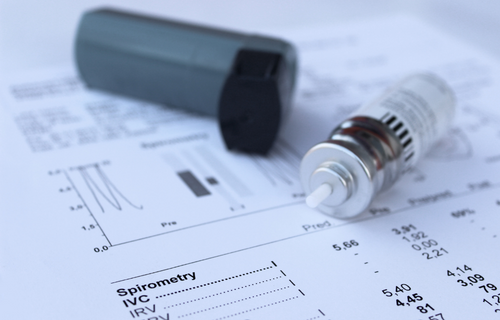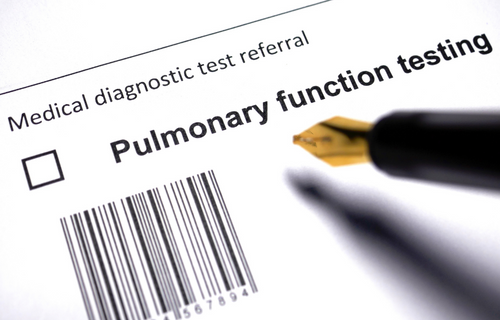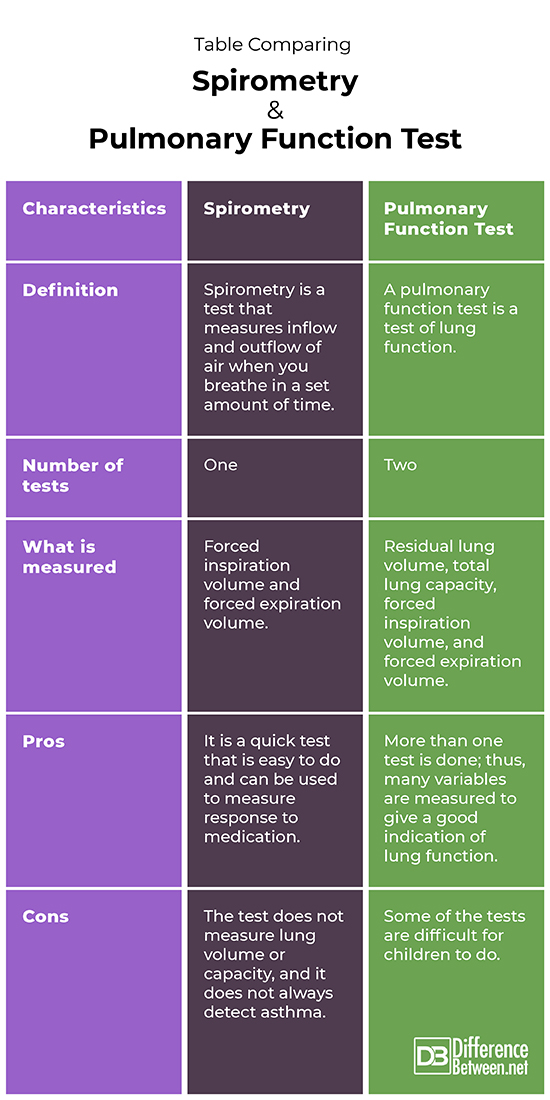Difference Between Spirometry and Pulmonary Function Test
Spirometry is a method used to measure how much air is breathed in and breathed out in a set amount of time. A pulmonary function test includes both spirometry and other tests such as body plethysmography.

What is Spirometry?
Definition:
Spirometry is one type of pulmonary function test in which the inflow and outflow of air are measured during breathing.
Method:
Forced expiration and inspiration are measured as the person breathes in a set unit of time. The Tiffeneau-Pinelli index is calculated and compared to reference values. If patients have abnormal values or this index is lower than normal, then it indicates a probable respiratory problem.
Diagnostic values:
An improvement in the one-second expiration, the FEV1, after medication, can show a person has asthma, but no improvement may show a person has some other lung disease.
Pros:
Spirometry can give an indication of a lung problem and is a fairly quick method to determine lung function. For most people, it is an easy test to do and it can also show if medication for asthmatics is effective.
Cons:
Spirometry is not always fully diagnostic in cases of asthma. It also does not measure total lung volume, which is a limitation of the procedure.

What is Pulmonary function test?
Definition:
Pulmonary function tests (PFTS) are tests done to measure how well your lungs are functioning.
Method:
Spirometry and bodyplethysmography are most often done when a PFTS is completed. These two tests are done by measuring how much air can be inhaled and exhaled and also the volume of air left in the lungs after breathing out. The last measure is done by plethysmography in which the person breathes while in an airtight box.
Diagnostic values:
The values of body plethysmography vary depending on gender, age, stature, and weight. A below-normal vital lung capacity will indicate a problem with the lungs; normal vital lung capacity varies from 3 to 5 liters for healthy adults depending on factors such as age, gender, and so on. The spirometry values will also be below normal when a person is ill, often they will be lower than 70%.
Pros:
Pulmonary function tests are useful in establishing how well a person’s lung is functioning. It can help diagnose lung and respiratory problems and also indicate if a person can undergo a general anesthetic safely.
Cons:
Children find the procedures difficult and the methods may be difficult for people who are coughing up blood.
Difference between Spirometry and Pulmonary function test
Definition
Spirometry is a test that measures the inflow and outflow of air when you breathe in a set amount of time. A pulmonary function test is a test of lung function.
Number of tests
Spirometry is only one type of test. Pulmonary function is tested with more than one kind of test.
What is measured
The variables measured by spirometry are the amount of air breathed out and in during a set time interval. Several variables are measured with a pulmonary function test including vital lung capacity and residual volume as well as expiration and inspiration volumes.
Pros
The advantage of spirometry is that it is a quick test that is easy to do and can be used to measure response to medication. The advantage of pulmonary function tests is that more than one test can be done meaning that a more accurate measure of lung function is obtained.
Cons
Spirometry does not always detect conditions like asthma and it doesn’t measure residual lung volume or lung vital capacity. Pulmonary function tests are sometimes hard for children to do and they can be a problem if a person is coughing up blood.
Table comparing Spirometry and Pulmonary function test

Summary of Spirometry and Pulmonary function test
- Spirometry is a type of pulmonary function test.
- Pulmonary function tests are those methods used to measure lung function.
- The most common pulmonary function tests are spirometry and bodyplethysmography.
FAQ
What are the different types of pulmonary function tests?
There are two commonly done types of pulmonary function tests, namely spirometry and a body plethysmography.
Is the pulmonary function test the same as a lung function test?
A pulmonary function test is a lung function test. The medical term pulmonary means lung.
Can spirometry be used to diagnose pulmonary diseases?
Spirometry can be used for the diagnosis of pulmonary illnesses such as COPD and asthma, although sometimes it requires additional tests or more than one spirometry measurement.
What is the spirometry test used for?
A spirometry test measures how much air is forcefully inhaled and exhaled in a certain time span to help give an idea of lung function.
What is a full pulmonary function test?
A full test of lung function would include both spirometry and body plethysmography. This way not only the amount of air breathed in and out is measured but also how much air your lungs can hold at a given time.
- Difference Between Rumination and Regurgitation - June 13, 2024
- Difference Between Pyelectasis and Hydronephrosis - June 4, 2024
- Difference Between Cellulitis and Erysipelas - June 1, 2024
Search DifferenceBetween.net :
References :
[0]Barreiro, Timothy, and Irene Perillo. "An approach to interpreting spirometry." American family physician 69.5 (2004): 1107-1114.
[1]Lessa, Thamine, et al. "Reference values for pulmonary volumes by plethysmography in a Brazilian sample of white adults." Jornal Brasileiro de Pneumologia 45 (2019).
[2]Ponce, Mario C., and Sandeep Sharma. "Pulmonary function tests." StatPearls [Internet]. StatPearls Publishing, 2020.
